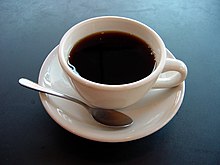Healthy eating habits/Calcium in the diet
Introduction
[edit | edit source]Calcium plays a role in many body functions. Firstly, it helps build and maintain bones; in fact 99% of the body’s calcium is found in bones. However, calcium is also involved in heart function, nerve transmission and blood clotting. Therefore, having an adequate calcium intake is important (Better Health Channel, 2013).
How To Improve Your Calcium Intake?
[edit | edit source]Easiest way is to eat more dairy/dairy substitutes.
The Australian Guide to Healthy Eating(AGTHE) can be used to check a person’s intake of milk, yoghurt, cheese and alternatives (MYCA) with the recommended amount (in number of serves) for their gender and age. The AGTHE also lists what 1 serve of each of these foods looks like e.g. 1 cup (250ml) of long life milk equals 1 serve. The AGTHE recommends that female uni students, aged between 19-50 years have 2 ½ serves of the MYCA group per day (NHMRC, 2013).
How to achieve 2 ½ serves of the MYCA group per day?
1 cup of milk=> 1 serve
¾ cup (or 200g) of yoghurt=> 1 serve
1 slice (or 20g) of hard cheese (e.g. cheddar)=>0.5 serve
=2 ½ serves per day
OR
2 cups of milk=> 2 serves
¼ cup (60g) of soft cheese (e.g. ricotta) => 0.5 serve
= 2 ½ serves per day
Alternative Sources of Calcium
[edit | edit source]Non dairy foods that are good sources of calcium and how their calcium content compares to that of dairy foods.
| Non-dairy foods | Amount of calcium (mg) | Dairy foods | Amount of calcium (mg) |
|---|---|---|---|
| Almonds 1 cup (143g) | 378mg | Yoghurt 1 cup | 450mg |
| Cooked turnip greens (1 cup boiled and drained) | 249mg | Milk (skim, low fat or whole) 1 cup | 300mg |
| Soybeans 1 cup boiled | 175mg | Cottage cheese 1 cup | 130mg |
| Sardines 1 cup drained (149g) | 569mg | ||
| Broccoli 1 cup chopped (91g) | 43mg |
(Robb, 2013), (Health Aliciousness, 2013),(UCSF Medical Centre, 2013)
If eaten in the right amounts non-dairy foods can deliver similar quantities of calcium as dairy foods or in some cases even more (as is particularly the case with 1 cup of drained sardines which contains 569mg of calcium). Furthermore you can combine non-dairy foods to increase your calcium intake:
E.g. By combining 1 cup of broccoli (43mg of calcium) with 1 cup of drained soybeans 175mg (calcium)
43+175= calcium intake of 218mg=> therefore your calcium intake would be more than 1 cup of cottage cheese (130mg) yet less than 1 cup of skim, low fat or whole milk (300mg).
Calcium Absoprtion
[edit | edit source]Factors that Enhance Calcium Absoprtion:
[edit | edit source]Stomach acid
-Makes calcium soluble (able to be dissolved ) (Whitney et.al, 2011)
-Breaks calcium down to facilitate its absorption in the small intestine (Arabia MSN, 2011)
Vitamin D
-Increases calcium absorption from the small intestine
-Decreases calcium loss through urine. (Norris, 2013)
Factors that Limit Calcium Absoprtion:
[edit | edit source]Phytates:

-Found in nuts, seeds and grains
-Class of antinutrients that have a high affinity for calcium
-They easily bind to calcium therefore limiting its availability for absorption
-Try not to eat phytate-containing foods and dairy foods together (American Bone Health, 2006)
Oxalates:

-Found in sweet potatoes, rhubarb, spinach and beetroot
-Very reactive molecules
-Bind to calcium therefore reducing its absorption
-Interfere with calcium storage in cells
-Don’t eliminate these food just be aware that they are not the best providers of calcium (Low Oxalate Diet, n.d.)
Alcohol:
-Interferes with vitamin D activation by the liver and kidneys (WebMD, 2013)
-Inhibits vitamin D activating enzymes in the liver (Office of Dietary Supplements, 2013)
-It is a diuretic therefore it increases calcium excretion through urine (Weil, 2013)
-Increases Parathyroid hormone (PTH) levels and therefore decreases calcium reserves in the body.
-Try to limit your alcohol intake (FIT Day, 2013)
Caffeine:

-In tea and coffee
-Drinking more than 3 cups of tea or coffee per day seems to decrease calcium absorption (National Osteoporosis Foundation, n.d.)
-It is believed that caffeine decreases calcium absorption by interfering with vitamin D absorption
-This area is still being researched
- Caffeine is also a diuretic therefore it increases calcium excretion in the urine
Further Reading
[edit | edit source]Effect of Vitamin D on Calcium
Extra examples of Non-Dairy sources of Calcium
References
[edit | edit source]American Bone Health. (2006). How do Phytates Impact Calcium Absorption? Retrieved from http://www.americanbonehealth.org/blog/?p=165
Arabia MSN. (2011). Stomach Acid Essential for Calcium Absorption. Retrieved from http://arabia.msn.com/lifestyle/christmas/13625/stomach-acid-essential-for-calcium-ab/
Better Health Channel. (2013). Calcium. Retrieved from http://www.betterhealth.vic.gov.au/bhcv2/bhcarticles.nsf/pages/Calcium
FITDAY. (2013). Alcohol and Osteoporosis. Retrieved from http://www.fitday.com/fitness-articles/nutrition/healthy-eating/alcohol-and-osteoporosis.html
Health Alicioussness. (2013). Top 10 Foods Highest in Calcium. Retrieved from http://www.healthaliciousness.com/articles/foods-high-in-calcium.php
Lindemann, K. (2013). Osteopenia: Osteopenia Treatments. Retrieved from http://www.osteopenia3.com/About-Osteopenia3.html
Low Oxalate Diet. (n.d.) Retrieved from http://lowoxalate.info/
National Osteoporosis Foundation. (n.d.). Food and Your Bones: More Tips For Eating For Good Bone Health. Retrieved from http://www.nof.org/foods
NHMRC. (2013). Healthy Eating For Adults: Eat For Health and Wellbeing. Retrieved from http://www.nhmrc.gov.au/_files_nhmrc/publications/attachments/n55g_adult_brochure.pdf
Norris, J. (2013). Calcium and Vitamin D. Retrieved from http://www.veganhealth.org/articles/bones
Office of dietary Supplements. (2013). Dietary Supplement Fact Sheet: Calcium. Retrieved from http://ods.od.nih.gov/factsheets/Calcium-HealthProfessional/
Robb, D. (2013). The Top 13 Non-Dairy Calcium Rich Foods. Retrieved from http://www.healthhabits.ca/2011/11/04/top-13-non-dairy-calcium-rich-foods/
UCSF Medical Centre. (2013). Calcium Content of Foods. Retrieved from http://www.ucsfhealth.org/education/calcium_content_of_selected_foods/
WebMD. (2013). Drinking Less for Strong Bones: How Does Alcohol Harm Your Bones? Retrieved from http://www.webmd.com/osteoporosis/features/alcohol
Weil, A. (2013). Osteoporosis Treatment. Retrieved from http://www.drweil.com/drw/u/ART02042/osteoporosis-treatment.html
Whitney, E., Rolfes, S.R., Crowe, T., Cameron-Smith, D & Walsh, A. (2011). Understanding Nutrition. South Melbourne, Vic: Cengage Learning.
